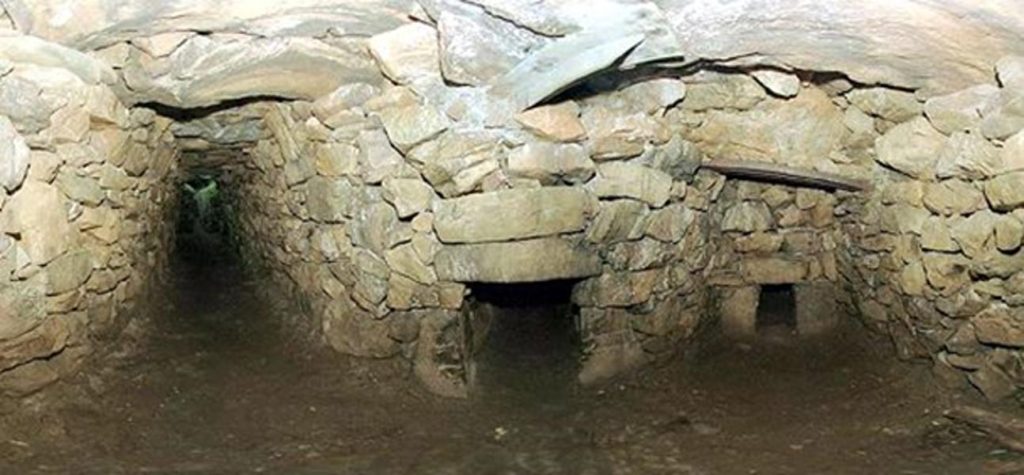The mystical landscapes of Cornwall, England, hold secrets from the past, shrouded in the enigmatic allure of time. Among the countless ancient stone structures scattered across this region, there are over a dozen tunnels that have captivated historians and archaeologists alike. These tunnels, known as fogous, are unlike anything found elsewhere in the British Isles. With their robust construction, supported by stone, they have withstood the test of time for approximately 2,400 years. Their purpose, however, remains a mystery, lost in the annals of history.
Prehistoric Tunnels
The fogous of Cornwall have intrigued researchers due to their unique nature and baffling origin. These subterranean structures, often referred to as caves, bear the name “fogou” in Cornish, derived from the word “ogo,” meaning cave. These enigmatic tunnels were excavated by antiquarians in the past, but the absence of meticulous records has left their true purpose shrouded in uncertainty. As we delve into the mysteries of these prehistoric tunnels, we explore the ancient landscape of Cornwall and the enduring enigma that surrounds the fogous.
Cornwall’s Ancient Landscape
Cornwall’s captivating landscape is adorned with a plethora of ancient stone structures, attesting to the rich history of human habitation in the region. From enclosures and cliff castles to roundhouses, ramparts, and forts, the Cornish countryside boasts a remarkable array of man-made features. Stone monuments such as barrows, menhirs, dolmens, cairns, and stone circles further contribute to the captivating tapestry of Cornwall’s past. Additionally, there are thirteen inscribed stones, each offering glimpses into the lives of those who once inhabited this land.

This land has witnessed the footsteps of countless generations, with evidence of human presence dating back thousands of years. According to Cornwall in Focus, the region is home to seventy-four Bronze Age structures, eighty from the Iron Age, fifty-five from the Neolithic era, and one from the Mesolithic era, which spans from 8000 to 4500 BC. With its diverse historical heritage, Cornwall stands as a testament to the enduring human spirit across the millennia.
The Iron Age and Fogous

Carn Euny fogou in Cornwall
The mysterious fogous are believed to belong to the Iron Age, a historical period spanning from around 700 BC to 43 AD. These underground tunnels, while distinctive in Cornwall, bear similarities to souterrains found in Scotland, Ireland, Normandy, and Brittany. The construction of fogous required considerable investment of time and resources, yet the purpose behind their creation remains elusive. Interestingly, all fourteen fogous discovered thus far lie within the confines of prehistoric settlements, further entwining their mysteries with the ancient communities that thrived in Cornwall.
The Mystery of Fogous
The inherent intrigue of fogous stems from the lack of written records left by the preliterate society that built them. Archaeologists and historians have grappled with deciphering their enigmatic purpose. With no concrete evidence to guide their interpretations, fogous have become a puzzle that defies easy solutions. Susan Greaney, the head properties historian of English Heritage, acknowledges the challenge of understanding these structures, given the limited excavations and their unwillingness to reveal their secrets.
Halliggye Fogou: The Best-Preserved Tunnel
Among the fogous that dot the Cornish landscape, Halliggye Fogou stands as a remarkable testament to their mysterious nature. This tunnel, considered the best-preserved fogou in Cornwall, is characterized by its impressive dimensions. The passage measures 1.8 meters (5.9 feet) in height and extends for 8.4 meters (27.6 feet). As one ventures deeper into the tunnel, a secondary passage branches off to the left, gradually growing darker and more foreboding. The culmination of this passage is marked by a “final creep,” where a stone lip awaits the unsuspecting explorer.

The design of fogous, including Halliggye, does not appear to prioritize easy access or comfort, raising further questions about their intended use. The BBC’s Amanda Ruggeri, in her exploration of Halliggye Fogou, noted the confounding nature of these structures that seem purposefully designed to discourage casual habitation or refuge.
Alternative Theories
In the absence of definitive answers, numerous theories have emerged regarding the purpose of fogous. Some speculate that these underground tunnels served as hiding places during times of conflict, offering sanctuary for the inhabitants of prehistoric settlements. However, the presence of visible lintels on the surface challenges this hypothesis. Ruggeri points out that staying in fogous would have been an inhospitable experience, making them unlikely hideouts.

Burial chambers have also been proposed as an explanation for fogous. An antiquarian who explored Halliggye Fogou in 1803 mentioned the presence of funerary urns. However, subsequent visits by others resulted in the removal of all urns, leaving behind no traces of bones or ashes. In fact, modern archaeologists have examined six tunnels and found no remnants of grains, suggesting that fogous might not have served storage or burial purposes.
These limitations in theories have led some researchers to consider the possibility of fogous being ceremonial or religious structures. Archaeologist James Gossip, during Ruggeri’s tour of Halliggye Fogou, expressed the idea that these tunnels may have been associated with “lost religions.” The purpose of worship and reverence may have been intertwined with the other functions, such as storage or shelter.
Changes in Purpose Over Time
Over the centuries, the purpose and use of fogous likely evolved with the shifting needs and beliefs of the communities that inhabited them. As societies changed and new cultural practices emerged, these tunnels may have served different functions, making it challenging to pinpoint a singular explanation. The absence of written records from the preliterate society further adds to the ambiguity surrounding fogous, leaving researchers with tantalizing glimpses into the past but no definitive answers.
Conclusion
The prehistoric tunnels of Cornwall stand as silent witnesses to the mysteries of ancient civilizations. The fogous, with their enduring construction and perplexing purpose, continue to intrigue and captivate the imaginations of historians, archaeologists, and curious minds. While theories abound, the enigma remains, inviting further exploration and speculation. As we marvel at the enduring legacy of these prehistoric tunnels, we are reminded that the past still holds secrets that may forever elude our understanding.



